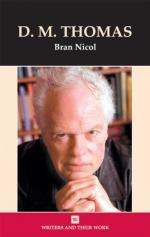|
This section contains 193 words (approx. 1 page at 300 words per page) |

|
[The Flute Player is] a fantasy about art and totalitarianism. The setting for this is an unnamed, vaguely representative city where pogroms, purges and plagues are unleashed upon the populace as temporary despots crash up and down on the switchback of power. The characters are vaguely representative as well—and none more so than the central figure, Elena, who has a 'flawless, rather enigmatic face' and appears to embody Love and Inspiration…. [She] is obviously on the side of life-enhancing creativity…. Disseminating her productive influence amongst the novel's arty personnel—'the poet', 'the painter', 'the sculptor' etc—Elena gives rise to numerous masterpieces, but can also fall prey to those whose relationship to the creative urge is more crooked….
Lurid inconsequentialities of narrative abound. But, trailing behind the novel's high-flown fantasies, are pedestrian, not to say lame, conclusions: 'the more the authorities glorified equality, the more unequal people...
|
This section contains 193 words (approx. 1 page at 300 words per page) |

|


